
Please send all Checks and Money orders to :
Dave Taylor P.O. Box 87 Sylvania, OH 43560
419-842-1863
Click Here to E-mail Us!


15 06 second list
LAYAWAYS ARE WELCOME:
Need to split your order into multiple payments? No problem! A simple 20% earnest money deposit will hold your item for you.
You can then pay it off in easy installments that fit your budget.
Read Terms Here
~~~~~~~~~~

15-06-31 … Very Large Bowie Knife …
Elegantly proportioned, very large size, clip-point Bowie Knife circa 1850-70. Measures a beefy 15 inches overall length. Of somewhat formal design is the round stag-horn grip with a downward turn, furnished with silver ferrule and large decorative silver spiral shell where the grip meets the guard. In my opinion this handle may have been replaced during the knife’s period of use. It is formal whereas the blade is utilitarian in form. The flat pommel cap, secured by three pins also looks like a period replacement to me. The blade is of wonderful classic 1850s era Bowie form, the handle looks like an 1860s formal knife. No nicks and not a trace of cleaning or grinding on the blade. Silver-gray in tone, there is some darker gray/pewter in patches along the upper sides near the back edge, and few more at the riccasso and along the blade, but nothing hideous and it’s a very a appealing knife with a robust ricasso. The blade really has “the look” of a killing tool, and whoever owned this knife took care of it and kept it in service … bej-17088
… $475.00 – SOLD
Click Here to E-mail Us!
Call us @ 419-842-1863

15-06-32 … Engraved Adams Army Revolver …
Profuse scrolling leaves cover the rear of the receiver on this hefty Beaumont-Adams. These five-shot, 44 caliber revolvers gave Colt a real run for his money in the British arms trade and were well-like exports, finding great favor among Confederate officers especially. They have solid frames, could operate as single or double action, (though this revolver currently only functions as double-action). This model has the longer grips for a more secure grip. It not only has the scroll engraving sometimes found on the top strap, but also full coverage on the rear of the frame from the top of the checkered grip forward to the front edge of the cylinder and on the small cover to the cap compartment on the base of the butt. “Adams Patent” markings and serial number 28147 engraved above the trigger guard, another number “907” stamped on the underside just forward of the cylinder. Left side loading lever, manufactured without recoil shield. Clear “ELG” stamp on the cylinder shows it was a product of one of the licensed Belgian makers. The mechanics are good except for the previously mentioned “functions only as double action”. The nipples are fine. Wood grip is excellent showing typical tight English checkering. The metal shows faint traces of faded blue turning a pewter tone on dull silver background. A darn nice revolver that has strong southern associations. In my personal collection I have a Richmond CS interlocking belt and buckle, with rebel pigskin holster containing one of these big English war horses. Great for display with CS cavalry or CS officer’s effects … rpet-aa
… $1,450.00 – SOLD
Click Here to E-mail Us!
Call us @ 419-842-1863

15-06-33 … Seventh Rhode Island Recruiting Poster …
Nicely presented Civil War recruiting broadside. Outside of frame Frame measures about 30 by 23 inches. Towns and municipalities often took up subscriptions to fund bounties for recruits in order to meet quotas for enlistments and avoid having to draft men. Here is a nice example from the 7th R.I. Volunteers seeking fifteen men for their company from South Kingston. The regiment was formed in May, 1862, and mustered into US service for three years in September. They joined the 9th Army Corps just after Antietam, in time for the blood-fest at Fredericksburg, where they lost 220 out of 570 engaged. In early February they followed Burnside and the rest of the corps to Suffolk, Virginia, and then west to Kentucky and Mississippi. In April, 1864, the corps returned to Virginia to take part in Grant’s overland campaign where they were heavily engaged at Spotsylvania and took part in other engagements leading up to Petersburg. There, they were stationed at Fort Sedgwick, known to some as “Fort Hell,” and served with the army through Appomattox and final muster out in June, 1865. Their casualties included 5 officers and 85 enlistedmen killed or mortally wounded during their service. Light water stain top left and lower left edge, minor foxing, vertical and horizontal fold lines, though just some small losses in lines 9 and 10. A very presentable poster that would look great in any Civil War display … cow-389-062014
… $1,750.00 – SOLD
Click Here to E-mail Us!
Call us @ 419-842-1863
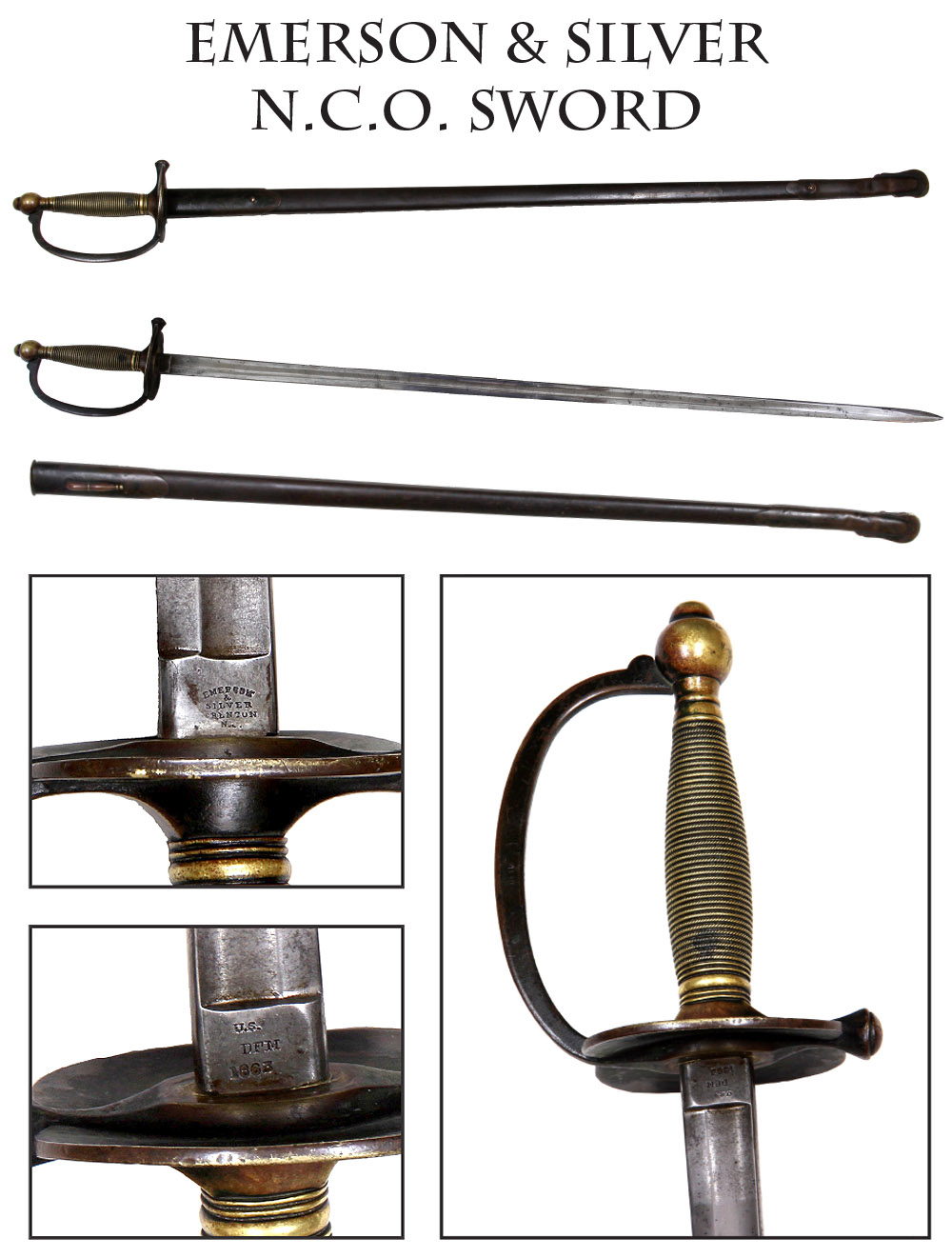
15-06-34 … Emerson and Silver 1863 Dated NCO Sword and Scabbard …
These 1840 pattern, long, straight-bladed swords were issued to infantry sergeants as badges of rank. This one is nicely marked and dated 1863 by Emerson and Silver of Trenton, N.J. One of the nice things about this company’s version of the sword is that they produced it with a steel scabbard that was far more sturdy than the usual black leather ones supplied by other makers. The blade on ours is in good condition, no edge nicks, clear marks on both sides of the ricasso, and a mixture of bright and gray color with a bit of brown but no pitting. The brass mounts have a nice aged patina and the scabbard has its original color and is free of dents. The grip and pommel shows a bit light from rubbing and handling, the guard and pommel match the mounts in a duller patina. A nice undisturbed example of regulation issue sword in good shape with a mid-war date and steel scabbard to boot. Perfect for display or careful use in reenacting … noco
… $475.00 – SOLD
Click Here to E-mail Us!
Call us @ 419-842-1863

15-06-35 … US Cavalry Officer’s Sword & Scabbard …
Handsome, unmarked import Yankee cavalry officer’s saber with nice detail and hand chasing on the guard, with a US etched blade. “Iron Proof” blade etching on the spine near the guard, typical of German made swords imported here by American retailers in large quantities during the war. A robust saber modeled on the US 1840 pattern. Hilt retains full leather on the grip and rare dragoon style “piano wire” twisted wire binding. Nice age darkened patina to the brass hilt and mounts. Pommel has a floral motif on its face that carries over to the leaves cast in the guard branches and inside of the counterguard. One slight crack in the outermost branch about one third of the way along. Nice brass throat and mounts, and drag has a nicely cast serrated edge and bound vine motif. Scabbard blue has shifted to brown, now mixed with dark spots, but with no substantial dents or dings. Blade shows the light remnants of etching: floral and geometric motifs, the “US” surrounded by sun rays shows well on one side. Overall blade is a mix of dull silver and light gray with a few darker areas. It has a good edge and no pitting. Blade pad still in place at the shoulder. A very presentable mounted officer’s saber priced friendly … noco
… $1,395.00
Click Here to E-mail Us!
Call us @ 419-842-1863

15-06-36 … Pettibone US 1872 Cavalry Officer’s Saber …
Pettibone is one of the more prolific military goods dealers of the late 19th century. The company came into being in 1872. Here is an example of their regulation 1872 pattern saber for cavalry officers, a style used all the way up to 1902, when it was replaced by a universal officer’s 1902 pattern. This has grip retaining about 100 percent of its sharkskin wrap, double twisted brass binding wire, and lots of the original gilding on the brass pommel, branches and counterguard … mixed with some duller tones on high spots from wear. Floral motifs on the pommel and branches, sunrays on the face of the counterguard and a dynamic eagle perched on arrows and olive branch on the inside, with stars arranged along the lower edge. Bright steel scabbard has a mix of bright and gray, a bit of brown coming up on the bottom at the drag. The mounts showing some gilt like the hilt and some duller brass like portions of the hilt. The blade has an unstopped fuller, impressed maker’s mark that indicates they were importing the blades from Germany, and nice “The Pettibone Bros. Mfg. Co. Cinti. O.” on one side of the long ricasso. There is an entwined US etched on the other side of the blade, extending into floral etching covering about half the blade with a nice spread winged eagle and motto backed by a spray of sun rays on one side. The blade pad is gone, the hilt is stable and tight. The use of Pettibone Brothers in the firm name started in 1895, making this a good candidate for use in the west and for the Spanish American War. Exactly what Teddy Roosevelts Roughriders officer’s carried when they were in the saddle. A lot of flash for very little money … bjj-17032
… $375.00 – SOLD
Click Here to E-mail Us!
Call us @ 419-842-1863

15-06-37 … 1865 Dated Roby Cavalry Saber and Scabbard – Note Saber Straps! …
A very nice, clearly marked and dated, 1860 pattern cavalry saber “in the bright” made by Christopher Roby of Chelmsford, Mass., in 1865, clearly dated and inspected. This sword even preserves the original cross polishing that was done at the base of the blade by the manufacturers and is usually gone from Civil War sabers. Deep and sharp Roby marks on one side of the ricasso. Equally crisp U.S. / 1865 stamp on the other along with the A.G.M. ordnance sub inspector stamp. Full leather wrap and wire binding on the hilt, just some light rubbing here and there. Nice muted patina to the brass. Blade pad still in place at the shoulder under the guard. Extremely clean and bright blade with only the tiniest scattered age spots. Scabbard is in the bright as well and preserves the matching “A.G.M.” inspector mark on the drag. Some brown age spotting scattered here an there, and a darker gray area above and below the middle the middle mount on one side. These 1865 sabers were late war issues that were out there in time for some of the great cavalry raids of the war and for some of the earliest actions on the plains. This one shows a characteristic “rattle dent” below the lower mount. It was a collector theory for a long time that these were put in to keep the sabers from rattling on the march and more firmly seated when sheathed. This was finally confirmed a few years ago with the discovery of an army directive to that effect. Also present are the buff leather saber straps off the trooper’s saber belt. These straps are extremely scarce on the loose. If you have a belt in need of straps I don’t know of another set for sale anywhere at this time. A nice cavalry saber and one of the most recognizable Civil War artifacts …
$850.00 with the straps … if you don’t want the straps I will sell just the saber and scabbard for … $695.00 – SOLD
Click Here to E-mail Us!
Call us @ 419-842-1863
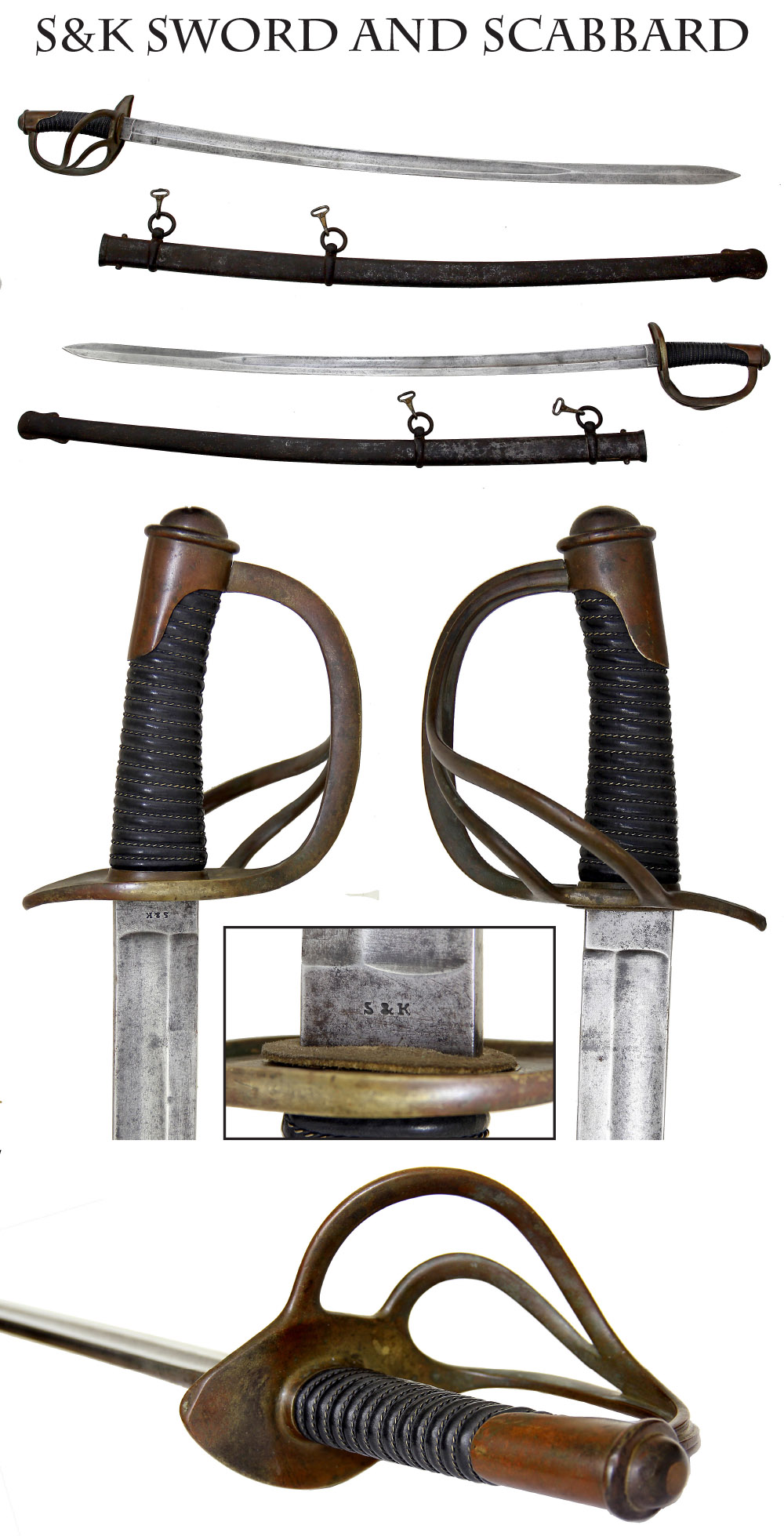
15-06-38 … Early S&K Sword and Scabbard …
Schnitzler and Kirschbaum were German sword makers supplying swords not only to the American commercial military goods market but also to the US government. Some of the first US 1840 pattern enlisted cavalry and artillery sabers were supplied to US by S&K. Many were used in the Mexican War. In the 1850s and 1860s they supplied many US retailers, and continued as a strong force in the arms trade until about 1864 when the firm seems to have dissolved. They supplied both British 1821/22 style steel hilted sabers, and brass hilted French pattern 1822 to American dealers (see Thillman on their offerings). (The French 1822 evolved to the 1840 US patterns and German Heavy patterns.) This specimen is the interesting early variation that utilizes their 1840 US hilt, with their earlier S&K British 1821/22 type blade and scabbard. This dates from the Mexican War or earlier. The grip leather and wire are spectacular restorations. I paid over $150 to have the grip restored EXACTLY as it was. The blade shows clear S&K stamp, mixed bright and gray overall with a good edge. Scabbard is the correct 1821/22 type with rivets top and bottom at the throat, gray and crusty brown overall. Two old snap hooks are attached to the carrying rings. The brass hilt has a nice undisturbed deep coppery tone. This is a very robust sword which likely saw use by US forces in the Mexican War. It is a scarce and interesting variant for the collector. The first such pattern I recall owning
… $750.00 – SOLD
Click Here to E-mail Us!
Call us @ 419-842-1863

15-06-39 … Two Very Solid Eagle Breastplates …
Each of these regulation circular eagle shoulder belt plates was worn on the shoulder strap of a Union soldier’s cartridge box during the Civil War, and each was lost or discarded by the soldier. They came out of an old collection in eastern Ohio accompanied by the note shown above. The note reads “From the battle of Gil Gal Church in July 1864. Gil Gal church was in the middle line of defense coming into the major battle of Kennesaw Mountain”. Unfortunately I do not know which plate the note originally came with. Sorry. Each plate has strong design on the face, solid lead-solder fill in the back, and both have the attaching loops rusted away. Good solid relics from the early days of metal detecting. The pair
… $225.00
Click Here to E-mail Us!
Call us @ 419-842-1863

15-06-40 … Southern Hillbilly CDV:
When I found this for seventy five dollars I could not pass it up. What a wonderful character study. This guy is the real deal, not some made-up for TV character who looks like an old fashioned Hatfield and McCoy hillbilly. This feller really is one. Has ink presentation note on the bottom front. No back mark
… $125.00 – SOLD
Click Here to E-mail Us!
Call us @ 419-842-1863
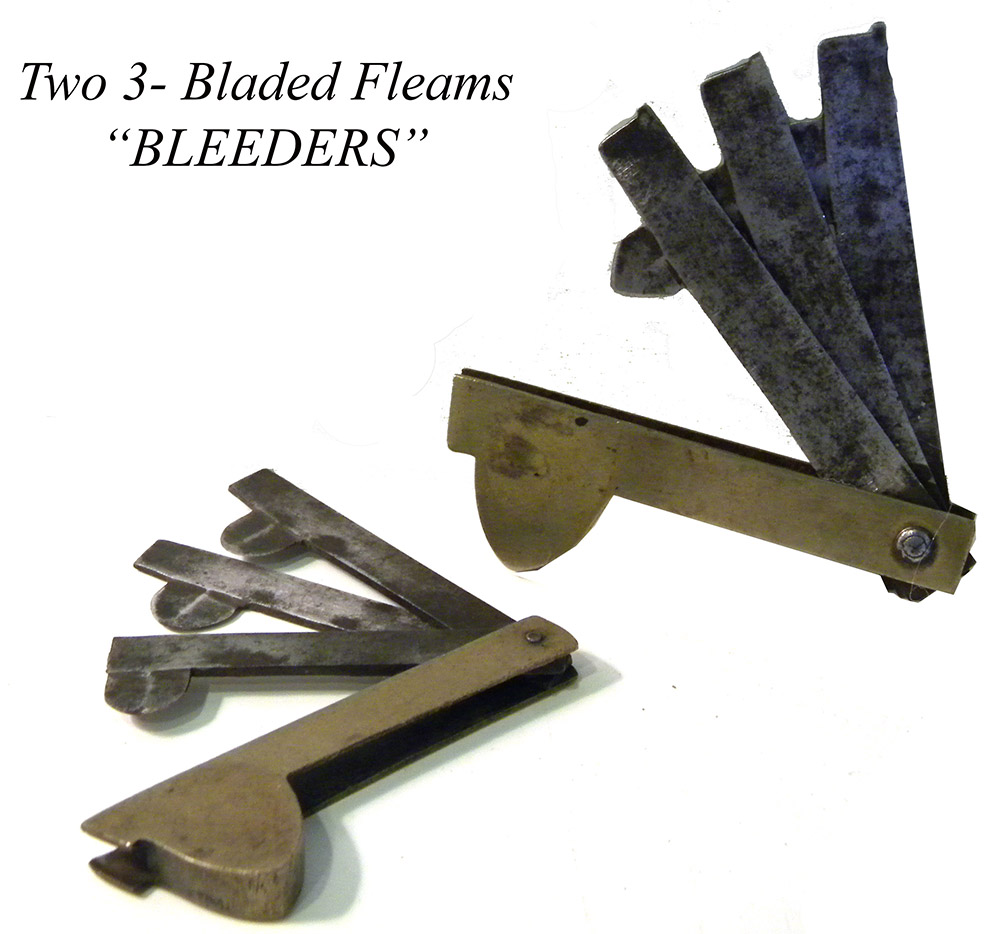
15-06-41 … Two Three-Bleaded Fleams – Bleeders …
A pair of early to mid 19th century brass handle bleeders. One measures 3.25 inches long. The other measures 3.12 inches long. VG condition. Unmarked. Great medical display items from the days when bleeding cured most of your ills. Get rid of that bad blood. The pair
… $135.00
Click Here to E-mail Us!
Call us @ 419-842-1863
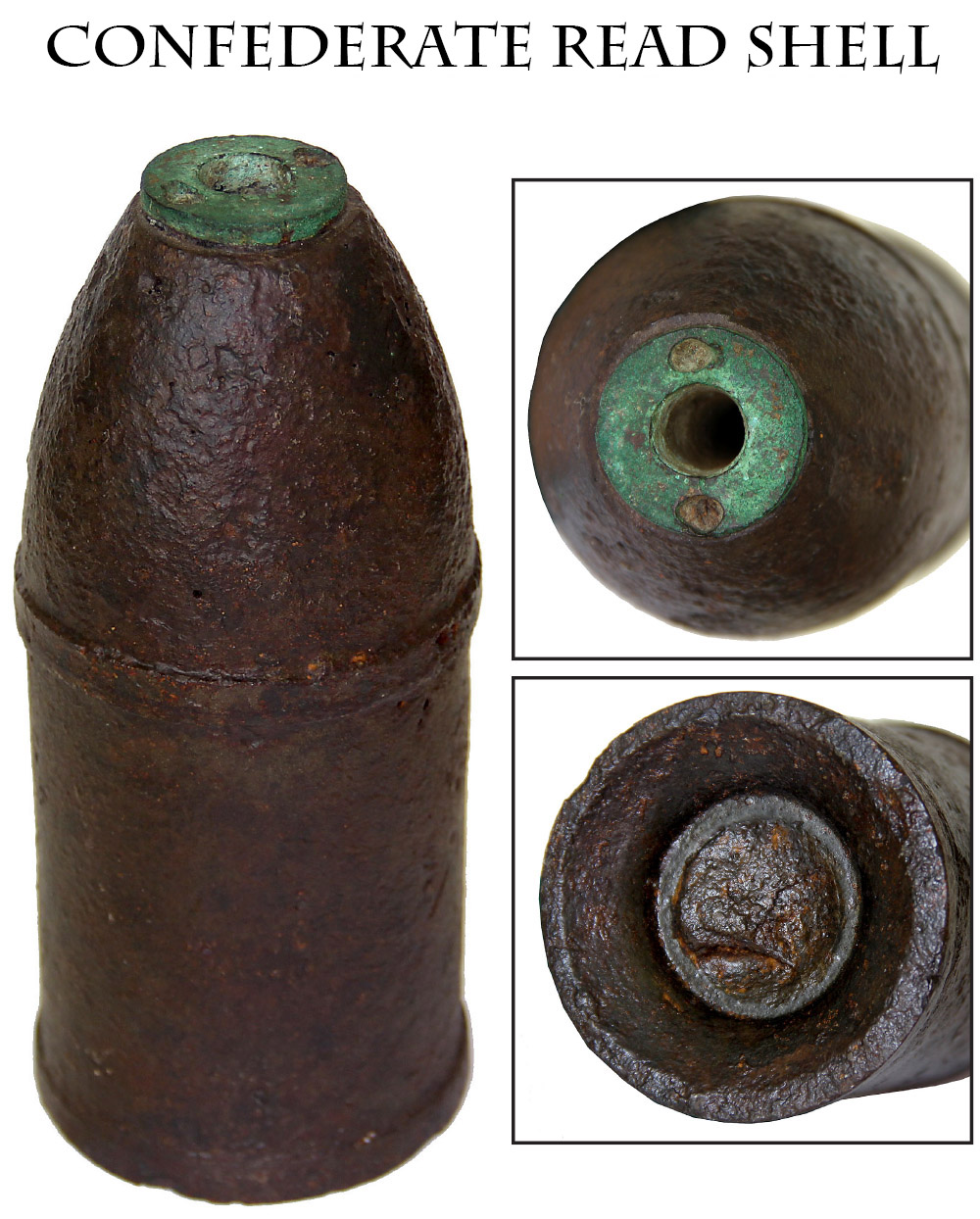
15-06-42 … Confederate 3-Inch “Virginia Type” Read Shell …
These bourelated 3-inch shells first show up in late 1862-early 1863 sites with wood fuzes. This one still retains the copper fuze adaptor that came in during the Spring of 1863. Excavated, of course, and no sabot, but very good overall condition with a great untouched look to it. Dickey and George note that the majority are found in 1863 contexts with a few left over in 1864, so it would seem a good Gettysburg period CS artillery round. I don’t handle shells very often, but this was an interesting one that came to me in an old collection where I had to “buy it all”. Neat rebel shell
… $295.00 – SOLD
Click Here to E-mail Us!
Call us @ 419-842-1863

15-06-43 … Extra Attractive 1847 Dated Missippi Rifle by Whitney / Original 54 Caliber! …
Nice Mexican War dated 1841 pattern rifle by Whitney in the original .54 caliber configuration. One of the best looking US martial arms ever produced. Whitney had four contracts for these arms between 1843 and 1855 for a total of 26,500 guns. This one has a sharp “E. Whitney” over US forward of the lock and “N.Haven” over 1847 to its rear. The barrel shows crisp US inspector JH initials and VP proofs at the left breech, just a little rubbing on the US, no “steel” stamp as is correct for this year. No tang date visible. Very little corrosion around the nipple. Nipple in good shape. Good wood to metal fit, just a slight space forward next to the breechplug tang. No wood burnout. Excellent wood edges … Very minimal wear to the front edge of the lock apron, likewise sharp edges on the flat opposite the lock. Very visible wood WAT cartouche on the offside. Minor handling marks, a few checks opposite the lock. Nice deep, rich tones to the wood and mellow patina to the brass. The wood has an old coating of lacquer or varnish that I have elected to leave as-found … Barrel is a lovely brown patina much the same color as when it left the factory with the lacquer brown finish. Some light peppering is seen on the lockplate, Sights in place. Correct rod, bands, springs and swivels. Nice rifling in the bore and best of all, the patchbox has
ALL THE TOOLS in place:
extra nipple, combination nipple wrench/screwdrivers, ball screw and corkscrew wiper. Whitney put a lot of money into gearing up for production of this rifle and the quality shows. A key US martial arm with great eye-appeal. A strong example of the famed “Mississippi” and the tools are certainly worth four hundred dollars all by themselves. Your wife will be impressed with your great taste
… $2,950.00 – SOLD
Click Here to E-mail Us!
Call us @ 419-842-1863

15-06-44 … Collins and Company Marked Socket Bayonet …
Regulation 1861 .58 caliber socket bayonet in overall VG++ condition. Overall smooth steel with some shine. Sharp US mark on the ricasso. Socket marked in small lettering “C & Co.” which shows manufacture by Collins and Company of Hartford. Also stamped with inspector’s initial “H” at the mortise. Forward section of the socket has three OLD shallow bangs where it appears the soldier used his bayonet to tap a nail into his winter quarters … OR … maybe some early 1900s era handyman at Bannerman’s was too lazy to hunt up a tack hammer and there were hundreds of these bayonets laying around which would serve his purpose. In any event the little dents are minor, not affecting the fit, and are mentioned only for the sake of accuracy. If I am not mistaken Colt’s Special Model 1861 muskets were issued with these C & Co. blades. Very good example, and on the scarce side. Would be a good match for a musket in the $1800 to $2500 value range
… $195.00
Click Here to E-mail Us!
Call us @ 419-842-1863
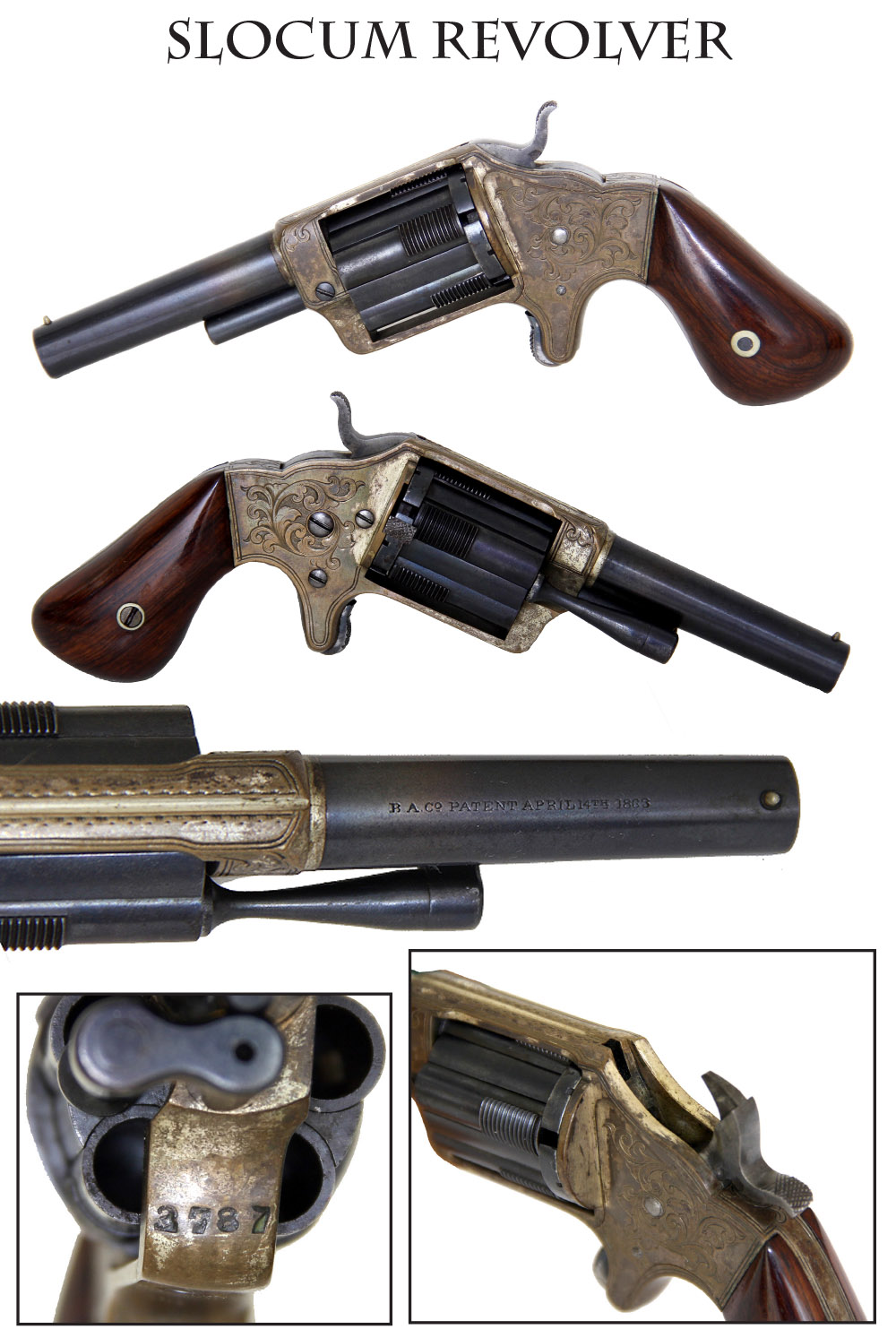
15-06-45 … Brooklyn Arms Company Slocum Revolver …
Exceedingly nice condition example of this cool little revolver. The Brooklyn Arms company managed to get around Rollin White’s patent for bored-through cylinders for their .32 rimfire pistols by devising a system of separate chambers that slid into grooves in the cylinder. The chambers could be moved forward over the backwards facing ejector on the right side of the barrel to eject old cartridges and enable a new one to be loaded. This gun has beautiful wood grips and sharp edges, and 3 inch barrel as is standard. All markings are vivid. The blue is near 100% and is an early refinish done by a master. The brass frame has vestiges of silver wash. The standard scroll engraving on the frame is super as is that on the top strap. Serial number 3787 stamped on the forward edge of the frame. Crisp “B.A. Co. Patented April 14, 1863” barrel stamp. Flayderman estimates a production run of something over 10,000 from about 1863 though 1864. A very pretty gun and a clever piece of engineering. One of my favorite Civil War revolvers, and one of the best looking examples I have owned … yy-iej
… $950.00 – SOLD
Click Here to E-mail Us!
Call us @ 419-842-1863
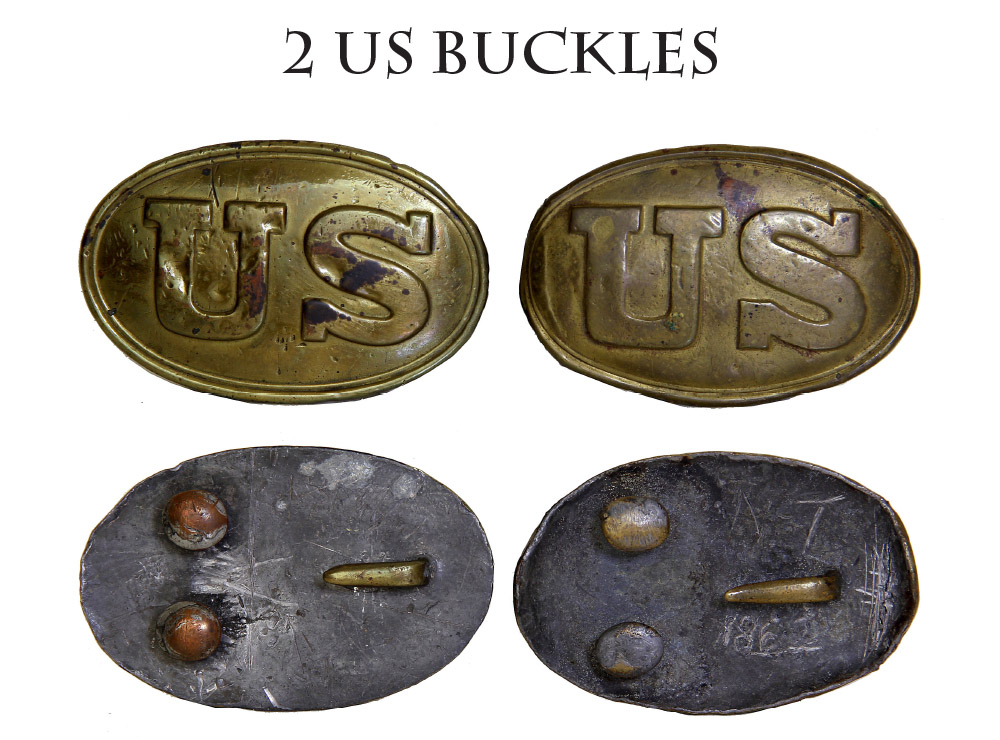
Two US “Puppy Paw” Belt Buckles …
The brass oval US belt plate with a lead solder filled back is the quintessential Civil War belt plate with lots of variation among makers. Non-dug, these are both early “puppy paw” style plates, one of which could date back to the Mexican War. The “tell” is the round studs (as opposed to oval) that secure the buckle to the belt. Each of these has the standard contoured heavy hook to fasten the belt closed.
ON THE LEFT … 15-06-46 …
Has perfectly round studs as seen on Mexican War dragoon belts… good edge, two small dents, and a few stains to the face
… $375.00 – SOLD
ON THE RIGHT … 15-06-47 …
Early rounded studs beginning to show slight oval shape… very early Civil War production… light bends to the left and right edges, minor dings and a stain at upper center to the face. Scratched note on the back “N T 1862”. Much much rarer than arrow hook buckles, and also scarcer than the oval “puppy paw” stud buckles
… $350.00
Click Here to E-mail Us!
Call us @ 419-842-1863

3 SOUTHERN SCENE STEREOVIEWS FORMER SLAVES …
Before the internet people enjoyed newsreels and slide shows of foreign scenes. Before that it was the stereoviewer. The hand held viewer was popular in all circles… passed around the parlor to see exotic locations in incredibly realistic 3-D format. These three views show the interest that scenes of the rural south held for viewers in pre 20th century America… particularly scenes of black life that must have seemed quite shocking in well-upholstered parlors up North. The southern viewer likely considered the images “life as it is”.
15-06-48-A … THE FIRST VIEW
shows “Uncle Isaac selling wood,” published by J.A. Palmer of Aiken, SC, who advertises he has, “a large stock of views of negro cabins, groups, teams, cotton fields and plants, etc….” In this scene a black man guides a two wheeled cart with a child perched on top. The cart is full of wood for sale with a nice two story house of the potential customer in the background. Without question Uncle Isaac had been born and lived a slave for most of his life. The child would grow up to experience all the racism rampant in the first half of the 20th century. This is the earliest of the three views likely dating 1870s or 1880s
… $175.00 – SOLD
15-06-48-B … THE SECOND VIEW
shows an older black couple in Kentucky, again undoubtedly former slaves, seated outside their wood cabin. Bottom of card imprinted with the title “Uncle Tom’s Cabin” and “The Old Folks at Home” a popular song more recognized by its alternate name Swanee River. The song represents slave life on the plantation as idyllic … “Way down upon the
Swanee River
“… tells the listener that the darkies longed for the old days,… the better days… of life on the plantation. Apparently the photographer felt this image of Aunt and Uncle qualified as representative, dated 1895
… $100.00 – SOLD
15-06-48-C … THE THIRD VIEW
is untitled but shows a black woman and man in a dirt street in front of picket fence behind which stands a somewhat dilapidated cabin. The man sports a rounded crown hat, well used dress or suit coat, matching trousers, and a walking stick clearly fashioned from a tree limb with lots of knots and twists. Under magnification we see he is much younger than the woman. I assume it is mother and son in front of their home, with the son dressed in his most dapper attire. The woman is closer, perhaps curious about the camera, and shows clearly her plain working dress making no pretense about her station in life. Circa 1890s, location unknown, but has a “deep south” feeling
… $85.00 – SOLD
Click Here to E-mail Us!
Call us @ 419-842-1863
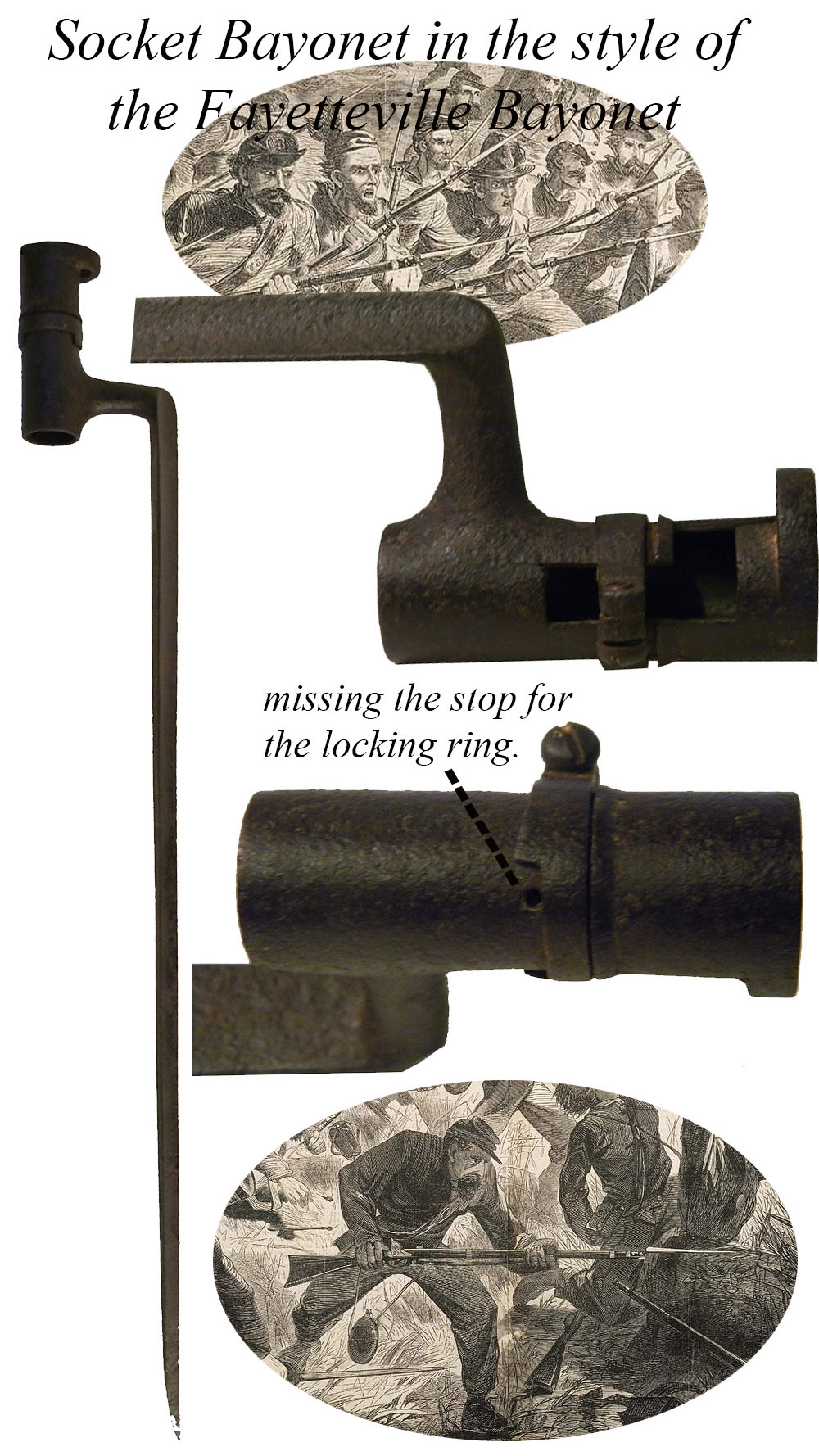
15-06-49 … Large Bore Socket Bayonet …
Very similar in style to the Fayetteville socket bayonet but enough different that I believe it to be for a European import musket. 21.25 inches overall. 18.25 blade length. 3 inch socket length, .82 inner diameter of socket. Brown crusty patina overall. Locking ring rotates freely. Missing the little ring stop on the socket which would be simple to replace. (Just bang a nail into the hole, finish it off, and rust it.)
… $100.00
Click Here to E-mail Us!
Call us @ 419-842-1863
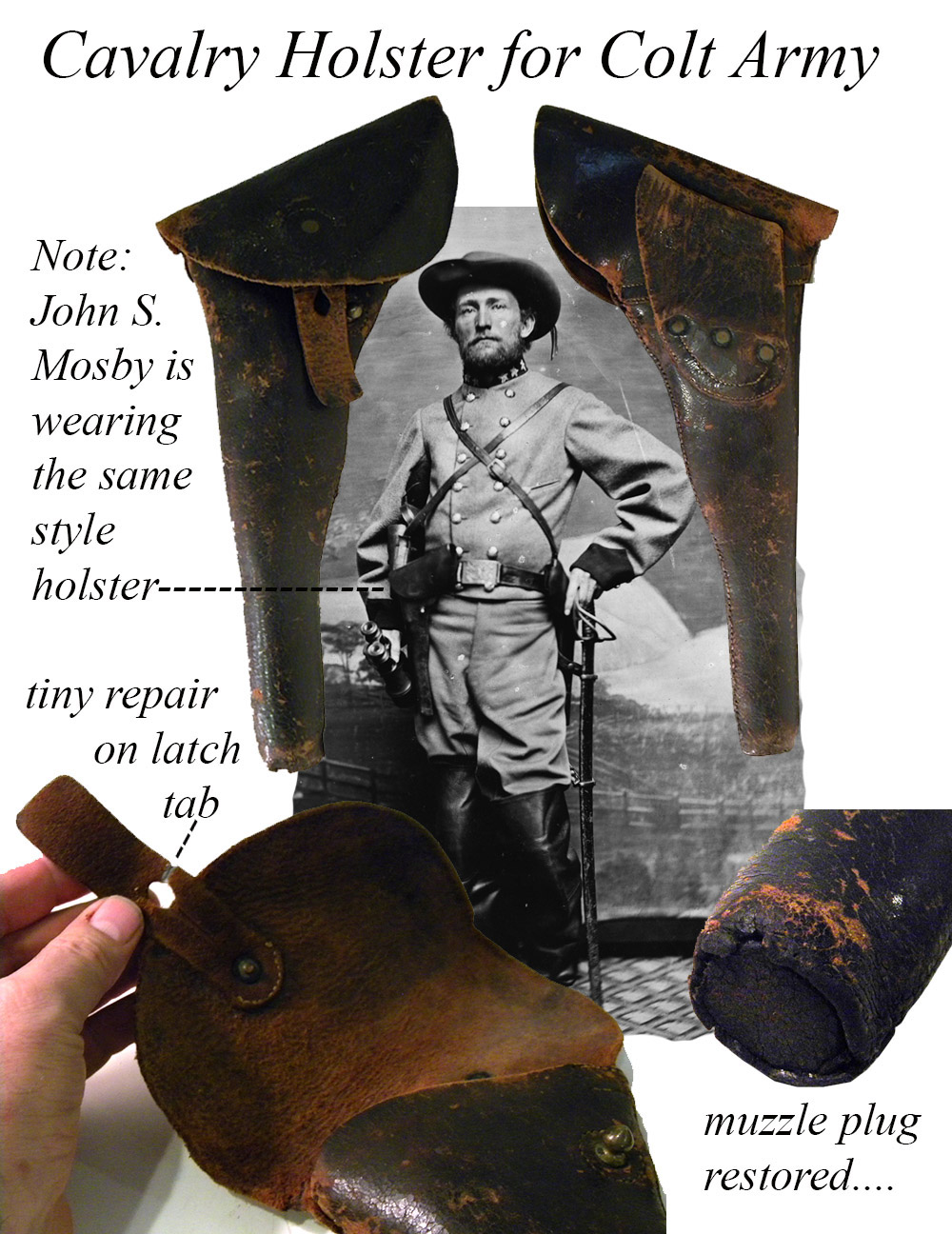
15-06-50 … Civil War Cavalry Holster For Colt or Remington Army Revolver …
Overall VG condition with good finish. Shows expected finish wear on the high spots. These holsters were issued with the Colt and Remington 44 caliber revolvers and fit either gun. They also accept Colt and Remington Navy revolvers just fine, just having a little extra room. The latch tab has a tiny repair as shown in the illustration. The end plug has been replaced… otherwise 100% original and as issued. A good solid example of the regulation issue full flap cavalry holster in the standard butt-forward configuration (butt forward when worn on the troopers right side). This design made it easier to draw when the holster was positioned,
“at the right side of the back,”
as Cooke phrases it in his 1861 cavalry tactics manual. The manual instructs … ”
At the command, (draw)… “PISTOL”, with the right hand unbutton the flap of the belt-hoister, draw the pistol, and, holding it at the stock, with the point of the forefinger reaching above the trigger guard, carry it vertically, with the hand as high as the right shoulder, and six inches in front of it.
Though, interestingly, Cooke did allow the trooper to hold the pistol with his left hand if necessary while cocking it with his right, before again bringing it to the “raise pistol” position in front of his right shoulder. We see by reading Cooke’s manual that the holsters were intended to be worn at the right hand side of the troopers back… a position too far for the left hand to reach and angled such that the right hand would require a “left hand draw” holster to facilitate the extraction of the revolver at that angle. Actual wartime photos of troopers generally show them wearing the holsters at their side, like our Mosby shown here. In that event the trooper might well have easier extracted his Colt with his left hand. One major auction house who should know better recently billed their regulation holster as an extremely rare “left handed” holster— go figure. These are getting tough to find in any sort of reasonable condition and are an iconic piece of cavalry gear
… $595.00
Click Here to E-mail Us!
Call us @ 419-842-1863
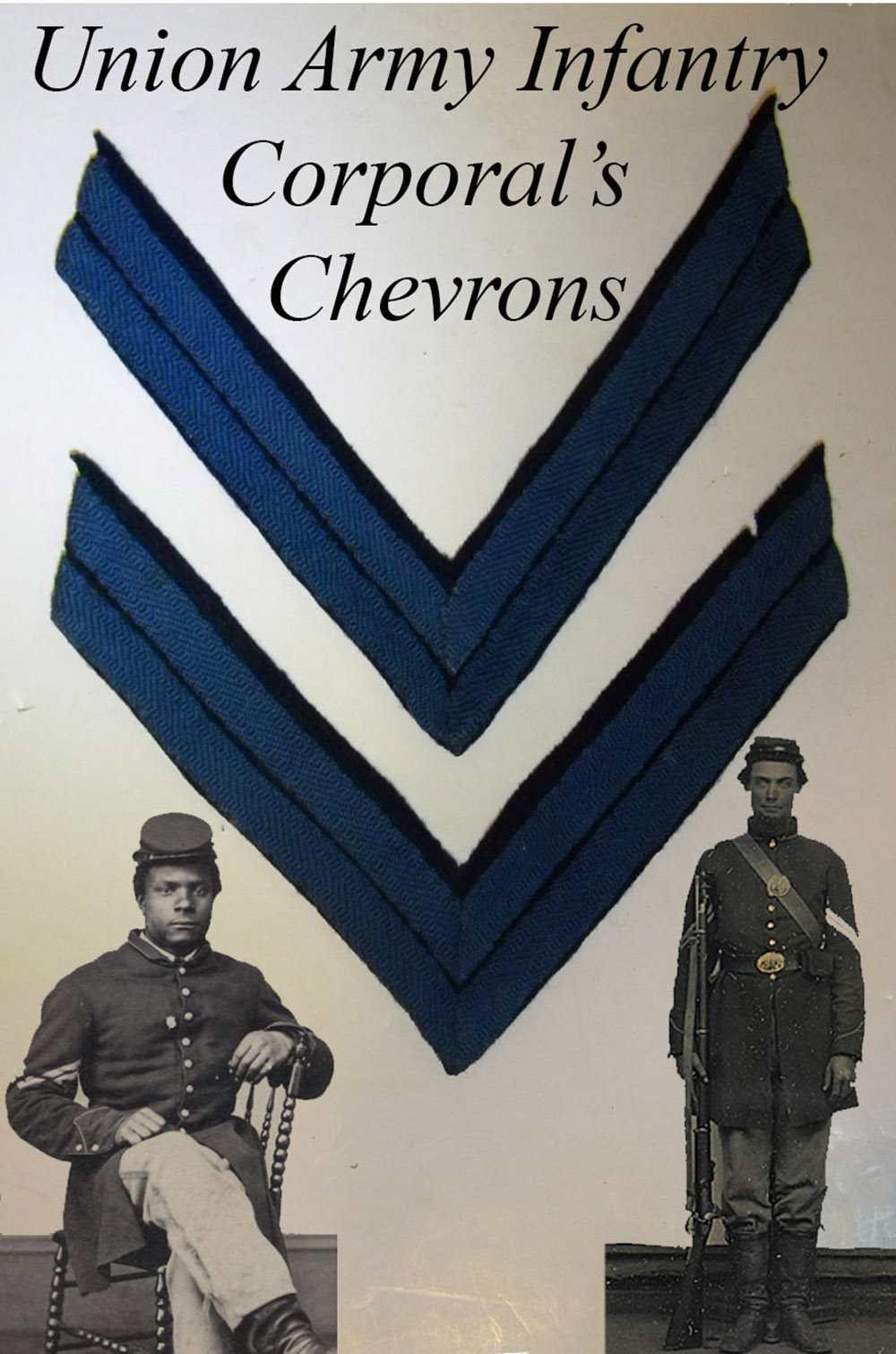
15-06-51 … Regulation Civil War issue Union Army Infantry Corporal’s Chevrons …
A matched pair of no-doubt-about-it … dead-real Civil War chevrons. Light blue worsted wool stripes with great sky blue color, sewn to the dark blue backing. A showy bit of insignia and a breath of fresh air in this world of postwar, dubious, reproduction, and fake examples which are always on the market. These are the genuine article… the “real deal”! I just completed an online research project for prices realized on chevrons at auction. I found in the last two years at Cowan’s auctions a pair of CW sergeant’s chevrons lotted with a pair of post war corporal’s chevrons brought 1,150.00. I also found an identified pair of corporal’s chevrons with the soldiers buttons and some calling cards brought $881.75. I found one lot of 1 pr of Corporal and 1 pr of Sergeant;s chevrons brought 1,667.00 for the pair at Julias. And I found a pair of sergeant’s examples that appear in the photograph to be reenactor’s replica chevrons brought 950 at another auction house. Here is a wonderful, genuine pair…. I used to be able to sell these for under 600 dollars, but they are getting impossible to find any more, and to buy them at auction is brutal. A wonderful pair
… $645.00 – SOLD
Click Here to E-mail Us!
Call us @ 419-842-1863
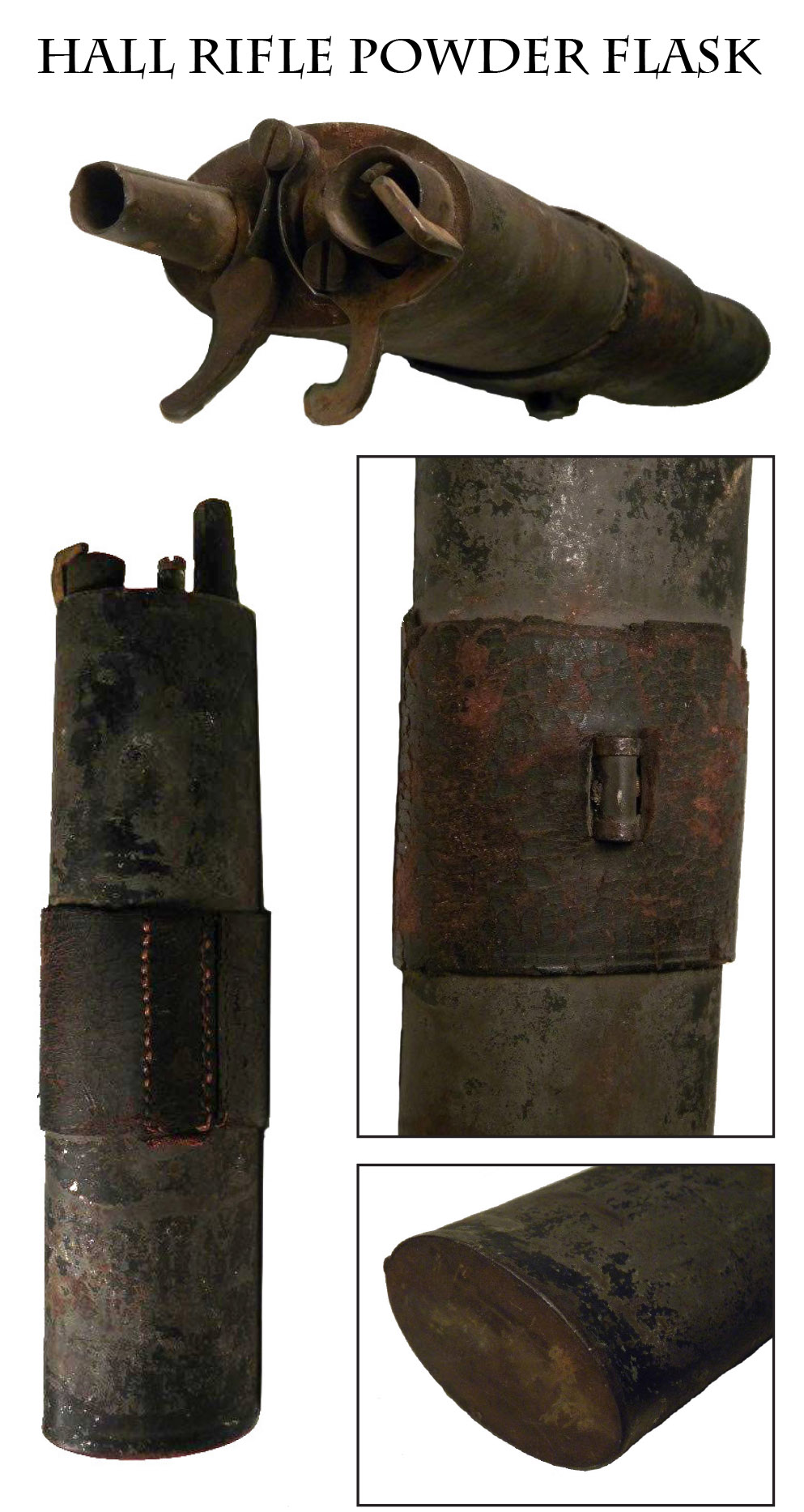
15-06-52 …
Extremely Rare hall Rifle Ammunition Flask Made at Harpers Ferry …
Very rare flask which was issued with the Model 1819 Hall Flintlock rifles. Constructed of tin, steel, and leather. 9-3/8″ long x 2-1/2″ x 1-1/2″ oval construction with 2 spouts & spring loaded levers for separately discharging powder & ball. This still has its original leather waistband intact with metal loop on one side and stitching on the other where there had been a belt loop which is now gone. This was the first flask produced under contract for the government in 1819 at Harper’s Ferry Armory. This flask held eighteen balls for the Hall rifle and 8 oz. of powder and is considered among the most rare of all martial flasks. Ref. Fig. 869,
The Powder Flask Book
, Riling. I note that the gutterman web page offers a pitted relic example for $4500, and a comparable example brought 3,737.50 at Julia’s auction way back in the Fall of 2008 (seven years ago). This is a very solid example retaining the leather band at the center. The first one I have owned, in my 45 years of hunting old junque
… $3,400.00 – SOLD
Click Here to E-mail Us!
Call us @ 419-842-1863
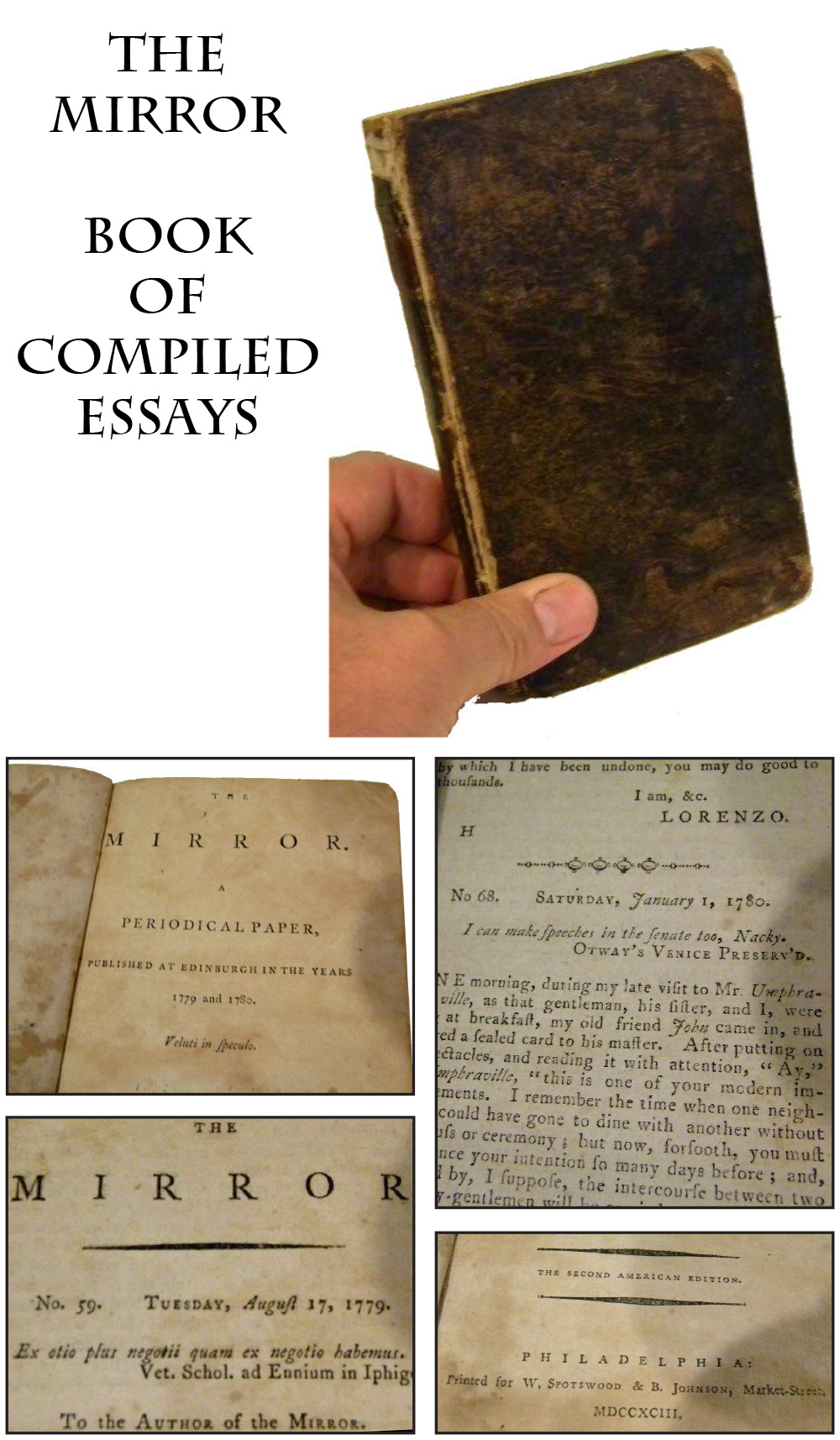
15-06-53 … “The Mirror” Book of Compiled Essays Philadelphia 1793 …
Interesting pocket sized edition of essays from “The Mirror,” a popular periodical literary magazine published in Edinburgh in 1779 and 1780. This is the second American edition, by Spotswood and Johnson of 1793. Leather bound, about a half inch thick. A civilian item, but from the period of Wayne’s Legion and the early Indian campaigns when educated officers were likely to carry some civilized reading material with them into the wilderness in their personal luggage. Front cover separated and back cover missing. A neat early USA book
… $85.00 – SOLD
Click Here to E-mail Us!
Call us @ 419-842-1863

15-06-54 … 1862 Dated St Louis Arsenal .69 Caliber Buck and Ball Ammo Crate …
Color-coded with a beautiful robin’s-egg blue paint, this crate was fortunately preserved by a soldier who needed a storage box and tacked two leather hinges onto the top after the ammunition had been distributed. The color is absolutely original and visually striking. (In the folk art market any early furniture painted this color is avidly pursued.) Both wood carrying handles in place. Wonderful paint overall with just very slight rubbing here and there from honest use.
Stenciled in black on each end is “1,000 MUSKET / B. & BALL CARt. / CAL…69/1,200 PERC CAPS” On one side is “FROM St. LOUIS/ ARSENAL,” the first line in an arc over the last word. The stencil on the top is tougher to read but might read “Genl. McNeil” in the top line, likely the commander to whom the ammunition was being shipped. The inside, though has the most interesting stencil, “[FA]BRICATED / S[t. LO]UIS ARSENAL / [SE]Pt. 1862” with the missing letters present, but covered by one of the slats of wood used to piece the lid together by the soldier to reuse it as a box- in any case the lettering is unambiguous- this is a wonderful early war ammunition crate that shipped cartridges made up in September 1862
… $1,495.00 – SOLD
Click Here to E-mail Us!
Call us @ 419-842-1863

15-06-55 … 1839 Dated Ames US Pattern 1833 Dragoon Saber …
The 1833 dragoon saber was modeled on the British 1822 light cavalry saber and introduced when the U.S. reinstated mounted troops in the U.S. army (after relying on state troops for cavalry after the War of 1812.) The new pattern had a quill-backed blade, brass guard with two branches, backstrap, flat bird’s head pommel, and a leather covered grip with twisted brass wire wrap and brass ferrule at the base. The leather grip is about 80 percent intact with some of the underlying wood showing through with a deep age patina. The wire is in place. “MPL/ ORD” ordnance stamp on one side of the quillon terminal disk, “WS” inspector stamp on the other. Legible and distinct blade markings: “NP Ames / Cutler/ Springfield/1839” engraved in script near the ricasso and matching “WS” inspector stamp at base of blade on one side, script “United States” over a wreath on the other. Leather pad in place at blade shoulder. Blade rates very good, with no edge damage and a mix of bright and dull silver tones with some darker gray areas. Scabbard shows mostly gray with dusty brown areas and some darker gray portions on the inboard side just above the drag. Throat, drag, and correct split rings are in place. There is a repair to a crease in the scabbard just north of the drag. This was the regulation arm of the US dragoon regiments until the 1840 “heavy cavalry” style sabers were adopted, and for some time thereafter until the new pattern could be produced and issued. Even then, many of these remained in the hands of militia groups and made their way into early Civil War service. If you collect American swords or cavalry gear, this is one of the “must have” pieces. Priced as friendly as I can make it: these don’t show up often in any kind of acceptable condition any more… this one is darn nice … h
… $1,350.00
Click Here to E-mail Us!
Call us @ 419-842-1863
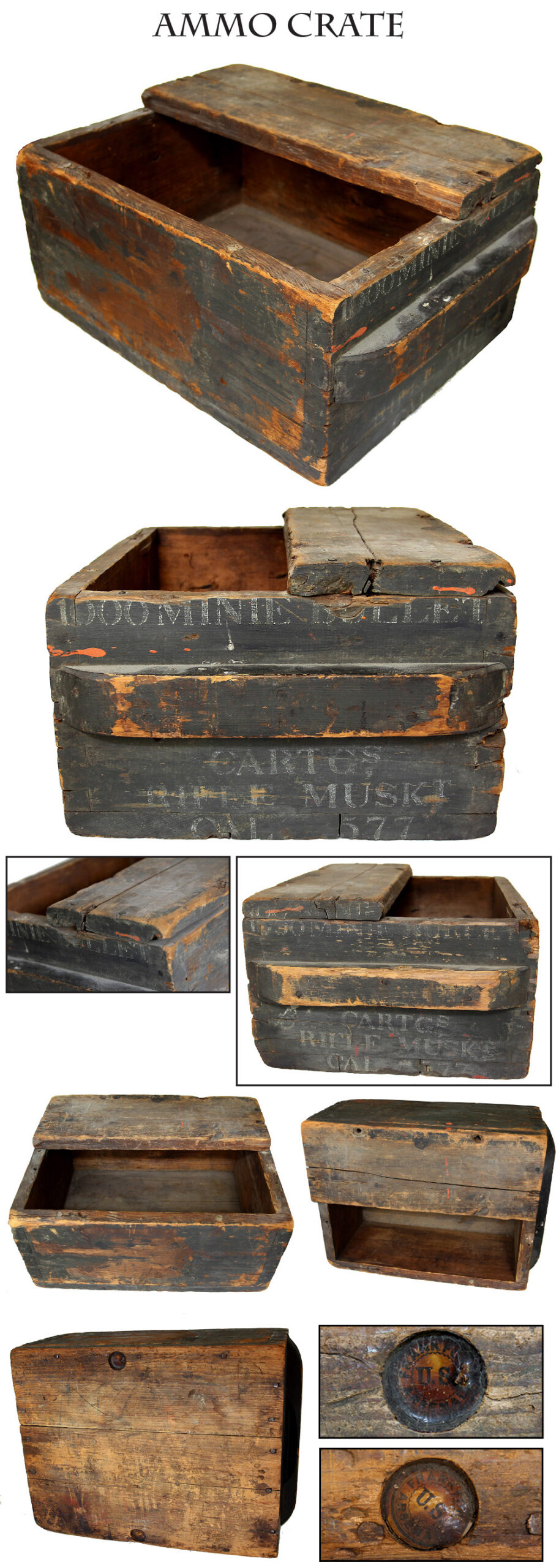
15-06-56 … Frankford Arsenal Crate for Rifle Musket .577 Minie Cartridges …
Ammo crates are one of the toughest Civil War items to find- they were everywhere during the war, but used up and burned for cooking. Rare to find in soldier’s effects. Here is an extremely scarce example for the Enfield cartridges … grayish/olive drab painted body… stenciled in white on each end: “1,000 MINIE BULLET / CARTG’s/ RIFLE MUSKt/ CAL. 577” The wood handles are in place and half the lid is still there, showing the top line of stenciling was done twice on one end. The holes for the heavy duty screws securing the lid are still there and about half the lid was kept and nailed back into place to use it for storage. The bottom of the crate is plain, without paint and still shows two Frankford Arsenal seals in recessed holes. The .577 caliber designation might indicate its intended use for Enfields, but in fact some ordnance letters of the time make clear it was a caliber designation for rounds intended for both .577 Enfields and .58 Springfield and Springfield contract rifle muskets. A few scattered paint drippings and wear to the top and some to the sides, but lots of original paint and very legible stenciling. A great display piece, and the first .577 crate I have owned
… $1,495.00
Click Here to E-mail Us!
Call us @ 419-842-1863

15-06-57 … 15-05-108 … Wolstenholm IXL Patriotic 2 Blade Folding Bowie Knife: …
Superb large (9 inches overall) silver mounted IXL folding Bowie Knife. Two bladed affair… main blade and an awl or punch. Tip of punch blade is broken off. Nicely marked with full George Wolstenholm firm marking and IXL brand which is of course a play on the words ” I Excel ” —- IXL. Shows expected wear and use but no abuse. Has classic American eagle motif on the central panel of the handle which is accented with mother-of-pearl insets flanking the eagle. Solid, rare, and very desirable in this large size. These were made 1850s into Civil War years and not after. A dandy patriotic knife
… $1,450.00
Click Here to E-mail Us!
Call us @ 419-842-1863

15-06-58 … US Navy Percussion Cap Box …
Identical to the army cap boxes except for the highly visual USN embossing on the front flap. About a hundred times rarer than army versions. Overall fine to excellent condition. Nicely marked with sub-inspector’s cartouche and makers name of R. NECE a famed Philadelphia accoutrement maker
… $395.00
Click Here to E-mail Us!
Call us @ 419-842-1863

15-06-59 … GAR Song Book and Two CDV Photos 74th Illinois??? …
A cute little GAR pamphlet printed in Omaha, Nebraska in 1882. Twenty neat GAR songs and interesting advertisements in the back. Accompanied by two Civil War CDV photos identified as Butler Ward and Jean McPherson Ward of Perry County New York circa 1862. Both photos have Rockford, Illinois back marks. I did a quick check in civilwardata without success. The National Park Service shows Butler Ward in the 74th Illinois. I’ll leave the rest of the research to you
… $59.00 – SOLD
Click Here to E-mail Us!
Call us @ 419-842-1863
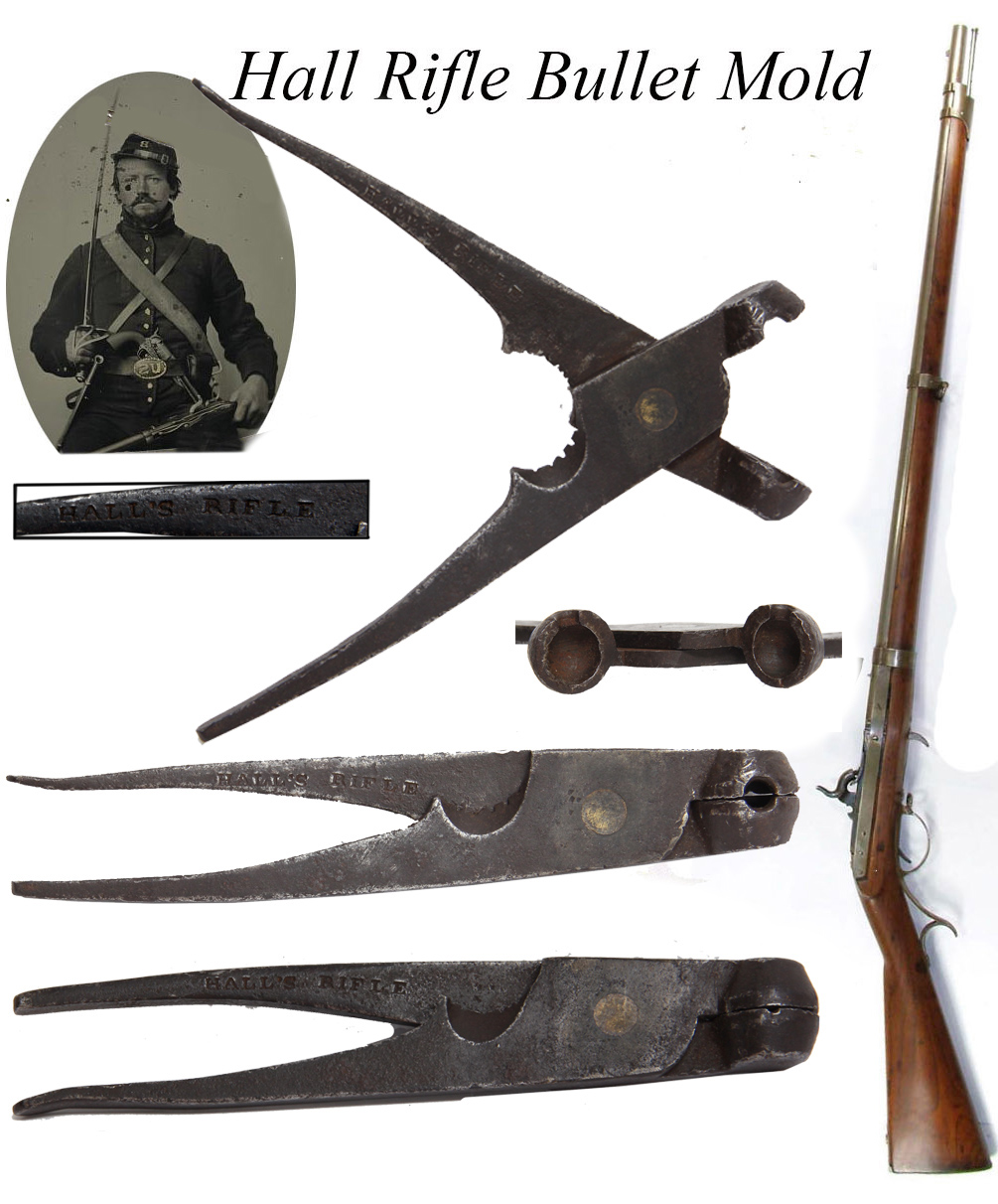
15-06-60 … Two Original Bullet Molds For “Hall’s Rifle” and so marked …
An extremely scarce piece of early American militaria are these single cavity, round ball, 52. caliber steel bullet molds which were made at the Harpers Ferry Arsenal. You will look long and hard to find one of these “sleeping” at a gun show or auction. I got these two out of an ancient collection of Hall guns and related. Both are fully functional with decent cavities. The top mold shown as number 1 is pitted along the handles. The “Hall’s Rifle” marking is visible but mixed with pitting. The bottom mold shown as number 2 is substantially better condition with only a little pitting. It has a clearer “Hall’s Rifle” stamping, much clearer even than it appears in the photo.. Doing a Google search today I find McPheeters Militaria page has a very nice example offered at $1500. Both of mine have some pitting and I am pricing them friendly at
… Mold No.1 $395.00 … Mold No.2 … $495.00
Click Here to E-mail Us!
Call us @ 419-842-1863
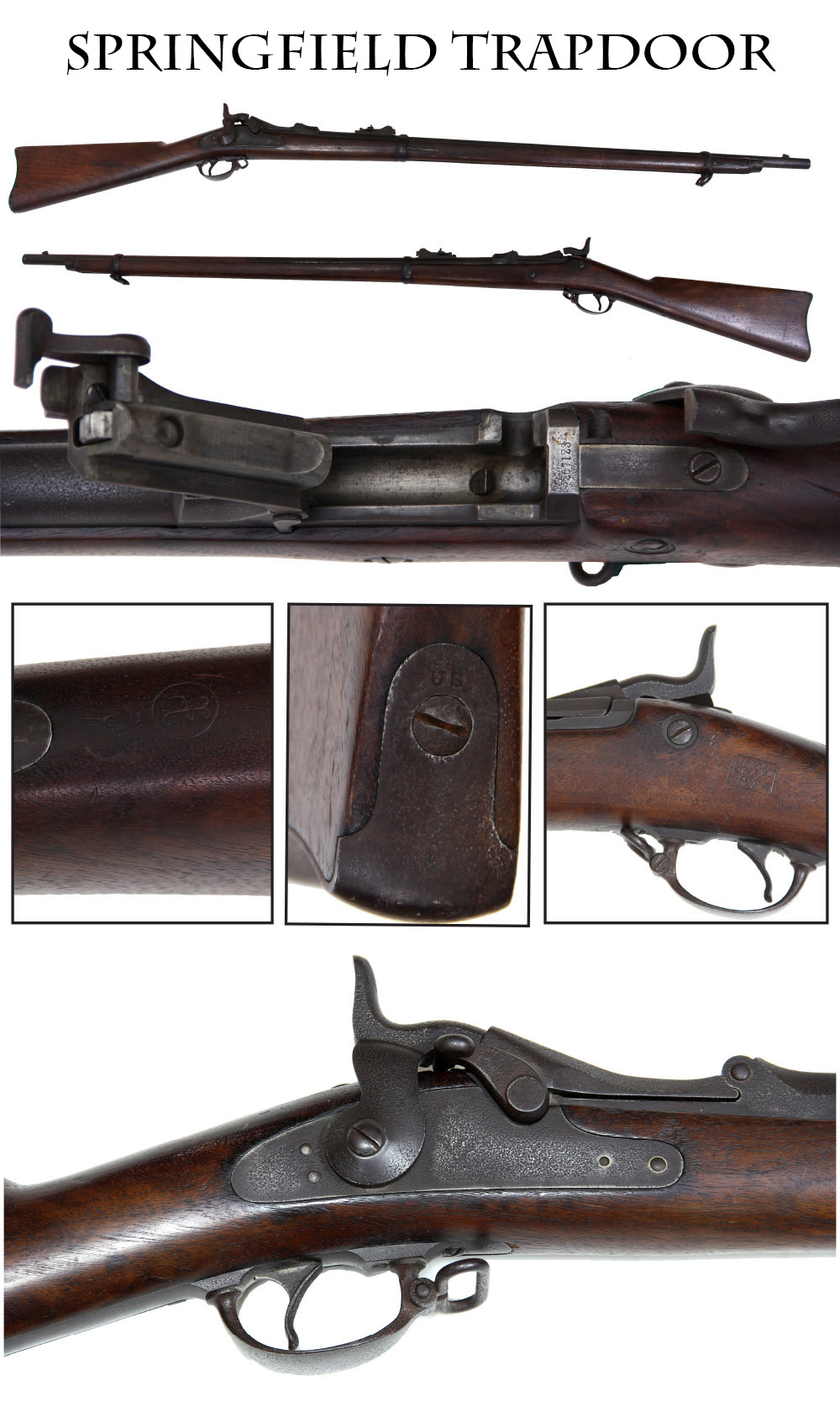
15-06-61 … M1884 Springfield Trapdoor …
This M1884 Springfield Trapdoor is well worn with some pitting on the lockplate, hammer and barrel … sn 867123 … no cleaning rod present … mechanically it still functions great … stock markings, US on the buttplate and eagle on the lockplate are still visable … despite the wear, a great value at
… $425.00 – SOLD
Click Here to E-mail Us!
Call us @ 419-842-1863

15-06-62 … A lot of TEN Original Indian War Large Size Eagle Coat Buttons.
A few years ago at an eastern Pennsylvania auction I bought a couple large bags full of these early Indian Fighters buttons and then I put them aside and forgot about them. I just stumbled across them again …. So here is a great opportunity…. ten original buttons for $25.00 These can be mailed inexpensively in a padded envelope.
… $25.00 for 10
Click Here to E-mail Us!
Call us @ 419-842-1863
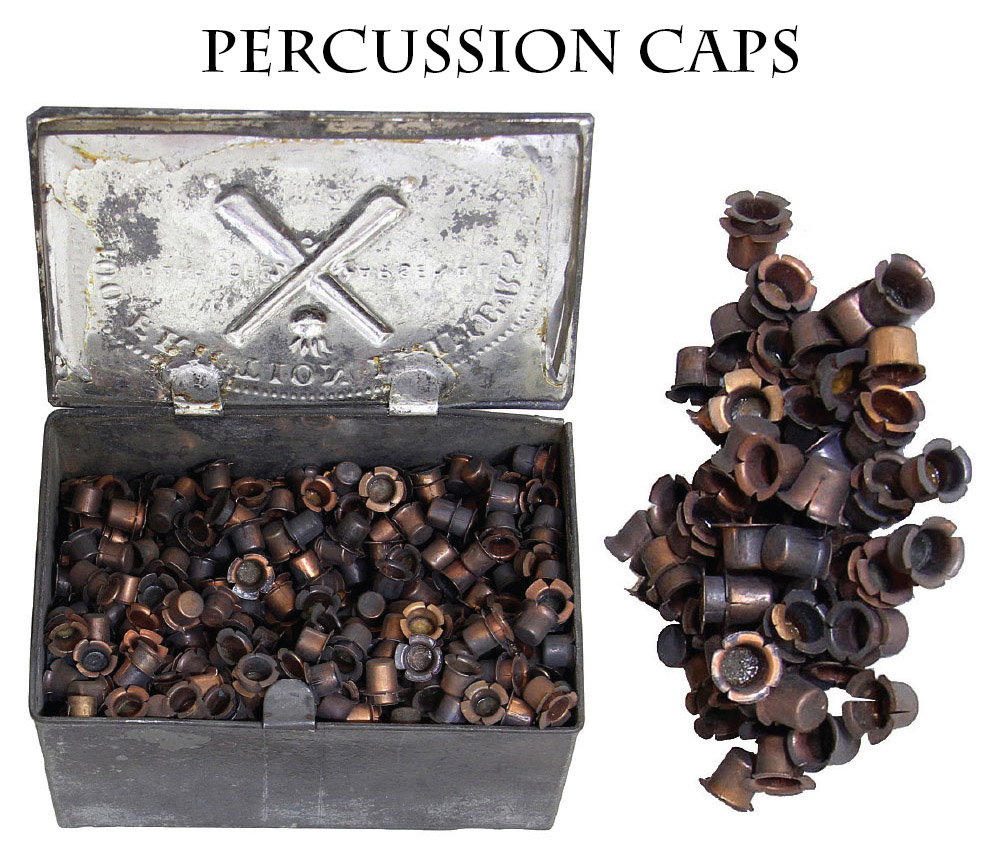
15-06-63 … Friction Primer Tin [Tin not for sale] and Percussion Caps …
I just purchased this neat old relic and am offering the percussion caps inside the tin in this offering. This very scarce tin came just as you see it, filled with percussion caps for muskets. The tin itself is the arsenal tin used to hold artillery friction primers. These are darned hard to find! I can only think of one instance where I found one still in a primer pouch! The tin has a hinged cover with small latch and embossed top reading: 100 FRICTION PRIMERS in an arc over an ordnance insignia, and FRANKFORD ARSENAL on either side. I don t know who put the percussion caps in the tin, it was certainly a handy storage idea, but since they do not belong together, I am splitting up the lot.
In each package of ten cartridges the soldier got 12 caps. While the supply lasts I will sell the percussion caps …
One Dozen … … … $15
Two Dozen … … … $25
Five dozen … … … $50
Click Here to E-mail Us!
Call us @ 419-842-1863

15-06-64 … These buttons were patented in 1862 by Abel Putnam
and made with a long spring shank and were designed to go through the grommets on issue rubber blankets so the sides could be connect ed and the whole thing worn as a poncho in rainy weather.The face is a standard Union Army eagle button. The back is a spring hook fashioned from double spring steel wire. I have very few priced each at
… $45.00
Click Here to E-mail Us!
Call us @ 419-842-1863
Layaways are Welcome
Need to split your order into multiple payments? No problem! A simple 20% earnest money deposit will hold your item for you.-acf
You can then pay it off in easy installments that fit your budget.
Read Terms Here
Items to Sell? Contact Us
I am always interested in buying ANYTHING from the American Civil War… Guns, Swords, Civil War Muskets, Knives, Uniforms, Flags, Medals, Badges, Diaries, Letters, Autographs, Buttons, photographs, tintypes, daguerreotypes, Insignia, Camp Items, Battlefield Relics, canteens, Drums, Etc… Call 419-842-1863 and ask for Dave Taylor.

